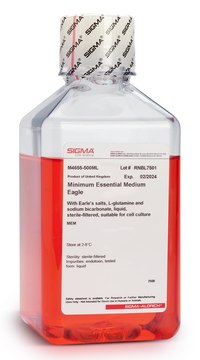B1522
Basal Medium Eagle
With Earle′s salts and sodium bicarbonate, without ʟ-glutamine, liquid, sterile-filtered, suitable for cell culture
Fabricação farmacêutica
Sinônimo(s):
BME
About This Item
Produtos recomendados
Nome do produto
Basal Medium Eagle, With Earle′s salts and sodium bicarbonate, without L-glutamine, liquid, sterile-filtered, suitable for cell culture
Nível de qualidade
esterilidade
sterile-filtered
Formulário
liquid
técnica(s)
cell culture | mammalian: suitable
Impurezas
endotoxin, tested
componentes
L-glutamine: no
NaHCO3: yes
Earle’s salts (5% CO2): yes
Condições de expedição
ambient
temperatura de armazenamento
2-8°C
Procurando produtos similares? Visita Guia de comparação de produtos
Descrição geral
Aplicação
- as a component in the culture medium for cochlear organotypic cultures and salicylate treatment
- to maintain cerebellar granule neurons (CGNs) to determine if there is a system that regulates the distribution and/or group dynamics of axonal mitochondria
- in the preparation of cortical slices, serum-free medium, and slice culture medium for slice overlay assay to study the influence of extracellular signals on neuronal development
Reconstituição
geralmente comprado junto com este produto
Código de classe de armazenamento
12 - Non Combustible Liquids
Classe de risco de água (WGK)
WGK 1
Ponto de fulgor (°F)
Not applicable
Ponto de fulgor (°C)
Not applicable
Escolha uma das versões mais recentes:
Já possui este produto?
Encontre a documentação dos produtos que você adquiriu recentemente na biblioteca de documentos.
Os clientes também visualizaram
Artigos
Cell culture protocol for passaging and splitting suspension cell lines
Nossa equipe de cientistas tem experiência em todas as áreas de pesquisa, incluindo Life Sciences, ciência de materiais, síntese química, cromatografia, química analítica e muitas outras.
Entre em contato com a assistência técnica









